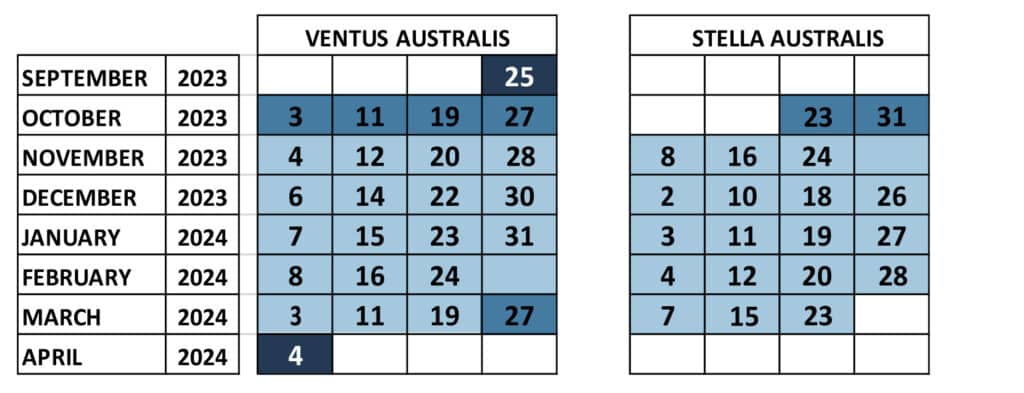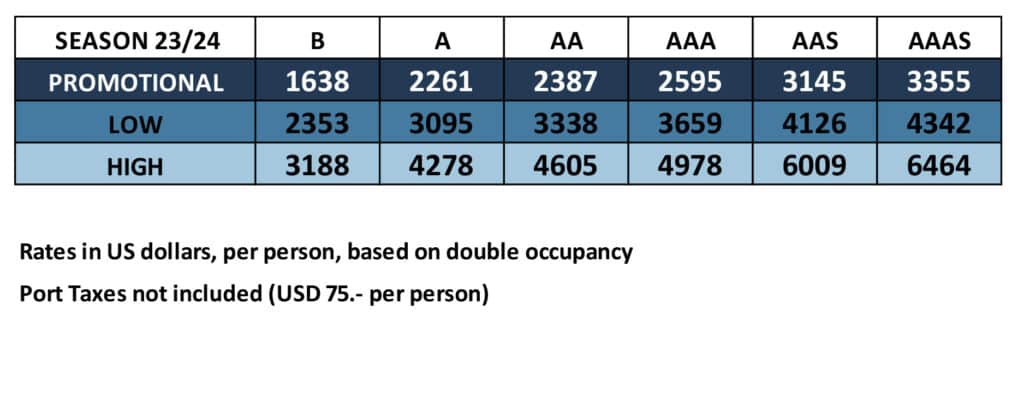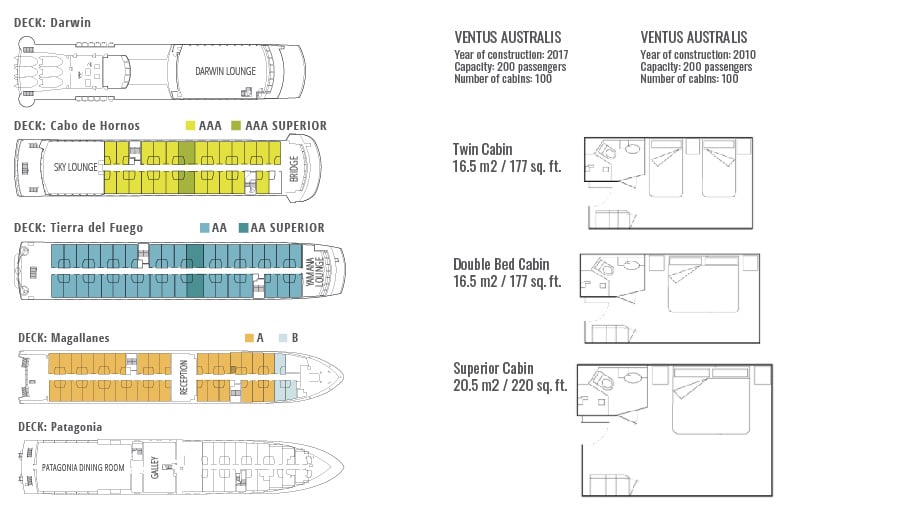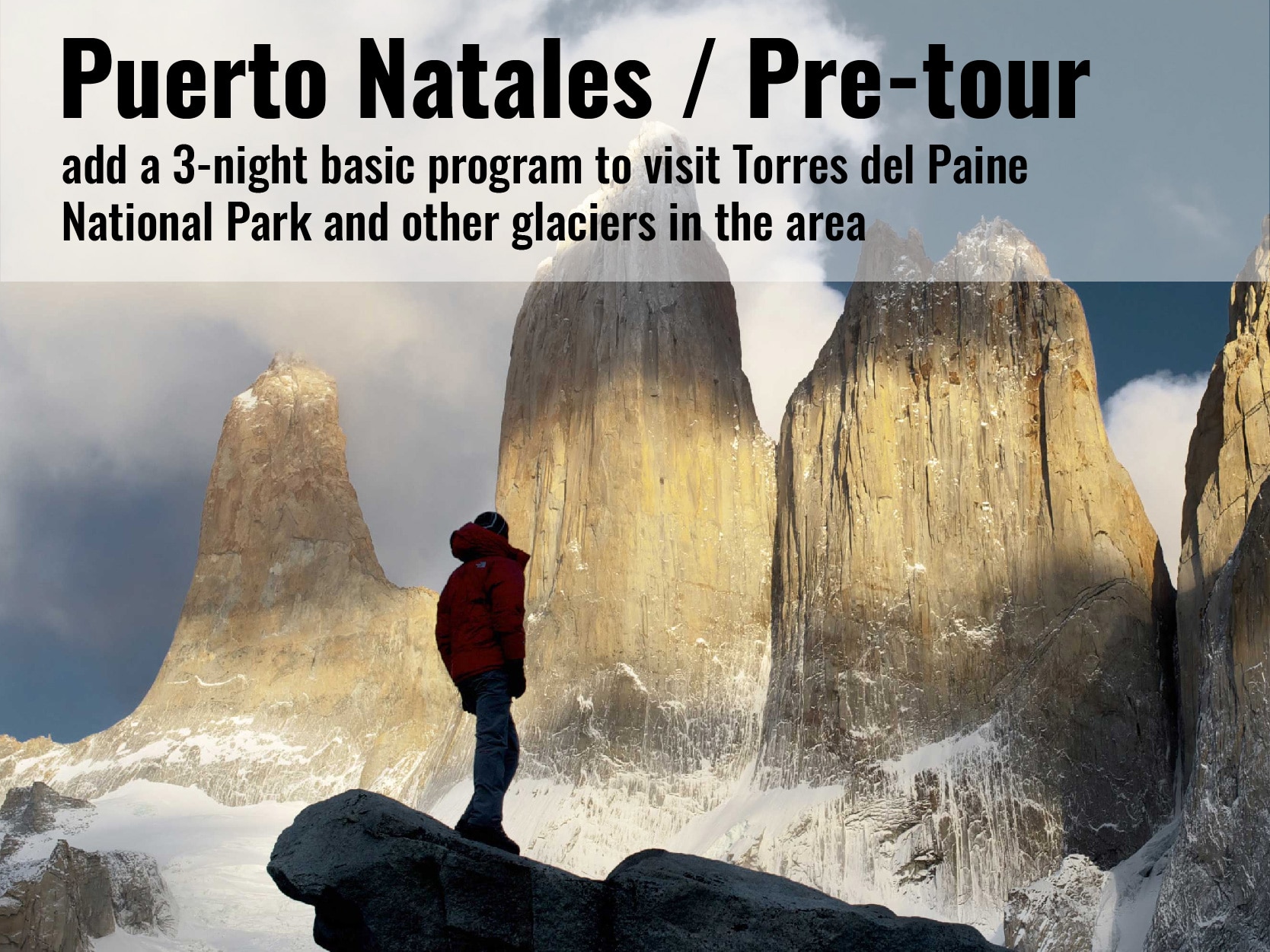
Best Season | Shoulder Season | Low Season | Not Available
The Australis Cruise: Fjords of Tierra del Fuego is an amazingly unique experience, aboard the incredible cruise expedition to visit the mythical Cape Horn and incredible fjords and glaciers in the remote southern portion of Patagonia. You will discover an excellent service aboard, while you enjoy the natural beauty of Patagonia and several of its most important historical sites. Whether you are sailing aboard the Australis Cruise, this four-day journey includes visits to wildlife-rich Ainsworth Bay, massive Pia Glacier and Glacier Alley, as well as mystical Wulaia Bay, the legendary Cape Horn.
The departure is from Punta Arenas port, and the cruise ends in Ushuaia. These are two historical important ports in the southern region of America. Explore some of the most incredible sceneries, enjoy nature and learn more about the history of these remote regions. See amazing animals, like penguins, sea lions, and dolphins. The Australis Cruises offers wonderful services aboard the ships. Great gastronomy, excellent disembarkation, and best guides. Explore this region of America!
Enjoy this incredible cruise and make unforgettable disembarkations!
Check in at 1398 Costanera del Estrecho Ave. (Arturo Prat Port) in Punta Arenas between 13:00 and 17:00 (1-5 PM)
Board the ship at 6 PM. After a welcoming toast and introduction of captain and crew, the ship departs for one of the remotest corners of planet Earth. During the night we cross the Strait of Magellan and enter the labyrinth of channels that define the southern extreme of Patagonian. The twinkling lights of Punta Arenas gradually fade into the distance as we enter the Whiteside Canal between Darwin Island and Isla Grande de Tierra del Fuego. It´s the beginning of a great experience aboard Australis!

After breakfast, be ready to enjoy your second day aboard the Australis Cruise. By dawn the ship is sailing up Admiralty Sound (Seno Almirantazgo), a spectacular offshoot of the Strait of Magellan that stretches nearly halfway across Tierra del Fuego. The snowcapped peaks of Karukinka Natural Park stretch along the north side of the sound, while the south shore is defined by the deep fjords and broad bays of Alberto de Agostini National Park. We go ashore at Ainsworth Bay, which harbors copious bird life and a colony of southern elephant seals which can sometimes be spotted from the Zodiacs. Two guided excursions are available: one is along the edge of a stream, peat bog and beaver habitat to a waterfall-and-moss-covered rock face tucked deep inside a pristine sub-polar forest; the other is a more strenuous hike along the crest of a glacial moraine. Both afford views of Marinelli Glacier and the Darwin Mountains.
Leaving our Ainsworth Bay tour behind, the Australis sail west along the sound to the Tucker Islets. After lunch, we board the Zodiacs again for a close-up view of the Magellan penguins that inhabit the tiny islands. More than 4,000 penguins use Tucker as a place to nest, give birth and nurture their chicks. Many other bird species also frequent the area including king cormorants, oystercatchers, Chilean skuas, kelp geese, dolphin gulls, eagles and even the occasional Andean condor. In September and April — when the penguins live elsewhere — this excursion is replaced by a short walk to a glacier at nearby stunning Brookes Bay.

Overnight we sail around the western end of the island, via the very narrow Gabrial Channel, Magdalena Channel and Cockburn Channel. After rounding the remote Brecknock Peninsula, the Australis cruise tacks eastward and enters the Beagle Channel again. By morning we are entering Pia Fjord and boarding the Zodiacs for a Pia Glacier tour. After disembarking we take a short hike to gain a panoramic view of the spectacular glacier, which extends from the mountaintops down to the sea or a longer much more difficult walk up a lateral moraine of the old Pia Glacier.
No one knows for certain how the hulking mass of snow and ice got its feminine moniker, but one theory says it was named for Princess Maria Pia of Savoy (1847-1911), daughter of the Italian king.
Back on board of the Australis ship, we continue east along the Beagle Channel through an area called Glacier Alley. Living up to its name, the passage features a number of impressive tidewater glaciers flowing down from the Darwin Mountains and Darwin Ice Sheet on the north shore. Most of them are named after European countries — Holland, Italy, Germany, Spain and France.
During the morning we cruise across Nassau Bay into the remote archipelago that includes Cape Horn National Park. Weather and sea conditions permitting, we shall go ashore on the windswept island that harbors legendary Cabo de Hornos. Discovered in 1616 by a Dutch maritime expedition — and named after the town of Hoorn in West Friesland — Cape Horn is a sheer 425-meter (1,394-foot) high rocky promontory overlooking the turbulent waters of the Drake Passage. For many years it was the only navigation route between the Pacific and Atlantic, and was often referred to as the “End of the Earth.” The park was declared a World Biosphere Reserve by UNESCO in 2005. The Chilean navy maintains a permanent lighthouse on the island, staffed by a lightkeeper and his family, as well as the tiny Stella Maris Chapel with a modern Monument at the end of a trail.
In the afternoon the Australis navigates the narrow Murray Channel between Navarino, Hoste islands and drop anchor at historic Wulaia Bay, one of the few places in the archipelago where human history is just as compelling as the natural environment. Originally the site of one of the region’s largest Yámana aboriginal settlements, the bay was described by Charles Darwin and sketched by Captain FitzRoy in the 1830s during their voyages on the HMS Beagle. This area is also renowned for its mesmerizing beauty and dramatic geography. After a visit to the Australis-sponsored museum in the old radio station — which is especially strong on the Yámana people and European missionaries in the area — passengers have a choice of three hikes (of increasing degrees of difficulty) that ascend the heavily wooden mountain behind the bay. On all of these, you will be strolling through an enchanted Magellan forest of lengas, coihues, canelos, ferns, but other endemic fauna to reach a panoramic viewpoint overlooking the bay. Before leaving Wulaia Bay, drop something into the wooden mail barrel inside the museum – letters or postcards meant to be hand-delivered by future travelers – an ancient mariner tradition revived by Australis.

The following morning we sail into Argentine waters and dock in Ushuaia, the world’s southernmost city.
Arrival at 08:30 a.m. and 9:30 am according to date of departure and disembarkation
If you continue with us with an organized itinerary, transfer to a hotel in Ushuaia or Ushuaia Airport to continue with your program. If you only booked the cruise we hope you enjoyed this amazing expedition.





PUERTO NATALES EXTENSION
Enjoy one of the must-see in Patagonia, visiting Puerto Natales. Yes, from there you can visit the unique Torres del Paine National Park and enjoy other glaciers in the area.
DAY 1 – Arrival to Puerto Natales!
DAY 2 – Visiting Torres del Paine National Park
DAY 3 – Enjoy a full day boat navigation to Balmaceda and Serrano Glaciers!
DAY 4 – Good bye Puerto Natales…
It`s just a suggested program, we can add or delete nights, and modify activities. If you`re looking for trekkings or a more active program based in trekkings in Torres del Paine, please ask for our 304 tour: Torres del Paine Basic Program.

USHUAIA EXTENSION PROGRAM!
Ushuaia is the southernmost city in the world. Add this extension and enjoy a 3-night package to visit Tierra del Fuego National Park, the Train of the End of the World, navigate the Beagle Channel, visit the mythical Museo del Presidio, see penguins, visit Fagnano and Escondido Lakes, and much more:
DAY 1 – Arrival to Ushuaia
DAY 2 – Visit to Tierra del Fuego National Park + Train of the End of the World + Beagle Channel Navigation.
DAY 3 – Choose from visit to Fagnano and Escondido, 4×4 ride in Tierra del Fuego Island, Trekking to Laguna Esmeralda and more
DAY 4 – Transfer out. Good bye Ushuaia








